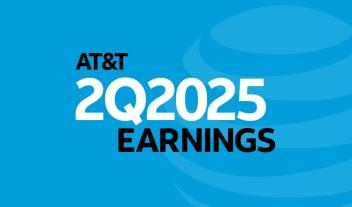AT&T Inc. (NYSE: T) reported strong second-quarter results that demonstrate its ability to grow the right way by attracting high-quality 5G and fiber subscribers, while growing service revenues, resulting in improved consolidated revenues and earnings growth.
“We are winning in a highly competitive marketplace, with the nation’s largest wireless and fiber networks. Customers are increasingly choosing AT&T because we have the best technology and options for wireless and broadband connectivity, backed by the AT&T Guarantee,” said John Stankey, AT&T Chairman and CEO. “The milestones achieved this quarter – from passing more than 30 million customer locations with fiber and eclipsing 1 million total AT&T Internet Air customers, to our agreement to acquire substantially all of Lumen’s Mass Markets fiber business – strengthen the industry's best and leading connectivity portfolio.”
Second-Quarter Consolidated Results
Revenues of $30.8 billion
Diluted EPS of $0.62, versus $0.49 a year ago; adjusted EPS* of $0.54, versus $0.51 a year ago
Operating income of $6.5 billion; adjusted operating income* of $6.5 billion
Net income of $4.9 billion; adjusted EBITDA* of $11.7 billion
Cash from operating activities of $9.8 billion, versus $9.1 billion a year ago
Capital expenditures of $4.9 billion; capital investment* of $5.1 billion
Free cash flow* of $4.4 billion, versus $4.0 billion a year ago
Second-Quarter Highlights
401,000 postpaid phone net adds with postpaid phone churn of 0.87%
Mobility service revenues of $16.9 billion, up 3.5% year over year
243,000 AT&T Fiber net adds and 203,000 AT&T Internet Air net adds
Consumer fiber broadband revenues of $2.1 billion, up 18.9% year over year
Repurchased approximately $1.0 billion in common shares
Closed the sale of entire remaining 70% stake in DIRECTV to TPG on July 2
Impact of Tax Provisions in the One Big Beautiful Bill Act
AT&T expects to realize $6.5 to $8.0 billion of cash tax savings during 2025-2027 relative to the guidance it provided at its 2024 Analyst & Investor Day due to tax provisions in the One Big Beautiful Bill Act. This reflects estimated savings of $1.5 to $2.0 billion in 2025 and $2.5 to $3.0 billion in each of 2026 and 2027.
The Company intends to invest $3.5 billion of these savings into its network to accelerate its fiber internet build-out to a pace of 4 million locations per year, a run-rate it expects to achieve by the end of 2026. As a result of this increased pace of organic fiber deployment, AT&T expects that by the end of 2030 it will reach approximately 50 million customer locations with its in-region fiber network and more than 60 million fiber locations when including the Lumen Mass Markets fiber assets it has agreed to acquire and plans to expand, its Gigapower joint venture, and agreements with other commercial open access providers1.
AT&T also intends to contribute $1.5 billion of these savings to its employee pension plan by the end of 2026, which would result in approximately 95% funding of the plan2. The remaining tax savings will add to AT&T’s financial flexibility to support additional strategic investments, incremental capital returns and debt repayment, among other potential uses.
Outlook
AT&T is updating certain elements of its financial guidance for 2025-2027 to reflect the impact of expected cash tax savings, as well as its year-to-date operating performance and outlook for the remainder of 2025. For the full year 2025, AT&T expects:
Consolidated service revenue growth in the low-single-digit range.
Mobility service revenue growth of 3% or better.
Consumer fiber broadband revenue growth in the mid-to-high teens.
Adjusted EBITDA* growth of 3% or better.
Mobility EBITDA* growth of approximately 3%.
Business Wireline EBITDA* to decline in the low-double-digit range.
Consumer Wireline EBITDA* growth in the low-to-mid-teens range.
Capital investment* in the $22 to $22.5 billion range.
Free cash flow* in the low-to-mid $16 billion range, including over half of the planned pension funding through 2026 discussed above.
Adjusted EPS* of $1.97 to $2.07.
Share repurchases of $4 billion for 2025, including approximately $1.3 billion completed year to date.
AT&T continues to operate the business to achieve the strategy outlined at its 2024 Analyst & Investor Day. Accordingly, AT&T reiterates its long-term financial outlook for:
Consolidated service revenue growth in the low-single-digit range annually from 2026-2027.
Adjusted EBITDA* growth of 3% or better annually from 2026-2027.
Adjusted EPS* accelerating to double-digit percentage growth in 2027.
As a result of the cash tax savings from provisions in the One Big Beautiful Bill Act, AT&T updates its financial outlook for:
Capital investment* in the $23 to $24 billion range annually from 2026-2027.
Free cash flow* of $18 billion+ in 2026 and $19 billion+ in 2027.
Note: AT&T’s second-quarter earnings conference call will be webcast at 8:30 a.m. ET on Wednesday, July 23, 2025. The webcast and related materials, including financial highlights, will be available at investors.att.com.
Consolidated Financial Results
Revenues for the second quarter totaled $30.8 billion, versus $29.8 billion in the year-ago quarter, up 3.5%. This was due to higher Mobility and Consumer Wireline revenues, partially offset by declines in Business Wireline and Mexico, which included unfavorable foreign exchange impacts.
Operating expenses were $24.3 billion, versus $24.0 billion in the year-ago quarter. Operating expenses increased, primarily due to higher equipment costs associated with higher wireless equipment revenues, and higher network-related costs. Additionally, depreciation increased from our continued fiber investment and network upgrades, partially offset by lower impacts from our Open RAN network modernization efforts. These increases were partially offset by expense declines from restructuring costs in the year-ago quarter and continued transformation efforts.
Operating income was $6.5 billion, versus $5.8 billion in the year-ago quarter. When adjusting for certain items, adjusted operating income* was $6.5 billion, versus $6.3 billion in the year-ago quarter.
Equity in net income of affiliates was $0.5 billion, versus $0.3 billion in the year-ago quarter, reflecting cash distributions received by AT&T in excess of the carrying amount of our investment in DIRECTV.
Net income was $4.9 billion, versus $3.9 billion in the year-ago quarter.
Net income attributable to common stock was $4.5 billion, versus $3.5 billion in the year-ago quarter. Earnings per diluted common share was $0.62, versus $0.49 in the year-ago quarter. Adjusting for $(0.08) which removes equity in net income of DIRECTV and excludes other items, adjusted earnings per diluted common share* was $0.54, versus $0.51 in the year-ago quarter.
Adjusted EBITDA* was $11.7 billion, versus $11.3 billion in the year-ago quarter.
Cash from operating activities was $9.8 billion, versus $9.1 billion in the year-ago quarter, reflecting operational growth and higher distributions from DIRECTV, partially offset by higher cash tax payments.
Capital expenditures were $4.9 billion, versus $4.4 billion in the year-ago quarter. Capital investment* totaled $5.1 billion, versus $4.9 billion in the year-ago quarter. Cash payments for vendor financing totaled $0.2 billion, versus $0.6 billion in the year-ago quarter.
Free cash flow,* which excludes cash flows from DIRECTV, was $4.4 billion, versus $4.0 billion in the year-ago quarter.
Total debt was $132.3 billion at the end of the second quarter, and net debt* was $120.3 billion.
Segment and Business Unit Results
Communications segment revenues were $29.7 billion, up 3.9% year over year, with operating income up 0.9% year over year.
Mobility service revenue grew 3.5% year over year driving EBITDA* growth of 3.2%. Postpaid phone net adds were 401,000 with postpaid phone ARPU up 1.1% year over year.
Mobility revenues were up 6.7% year over year driven by service revenue growth of 3.5% from postpaid phone average revenue per subscriber (ARPU) growth and subscriber gains, as well as equipment revenue growth of 18.8% from higher wireless device sales volumes. Operating expenses were up 8.4% year over year due to higher equipment expenses driven by higher wireless sales volumes and the sale of higher-priced devices. This increase also reflects higher network costs, higher advertising and promotion costs, and increased depreciation expense. Operating income was $6.9 billion, up 3.2% year over year. EBITDA* was $9.5 billion, up $292 million year over year.
Business Wireline revenues declined year over year driven by continued secular pressures on legacy and other transitional services that were partially offset by growth in fiber and advanced connectivity services.
Business Wireline revenues were down 9.3% year over year due to declines in legacy and other transitional services of 17.3%, partially offset by growth in fiber and advanced connectivity services of 3.5%. Operating expenses were down 3.0% year over year due to lower personnel and lower customer support costs associated with ongoing transformation initiatives, partially offset by higher depreciation expense due to ongoing investment for strategic initiatives such as fiber. Operating income was $(201) million, versus $102 million in the year-ago quarter, and EBITDA* was $1.3 billion, down $168 million year over year.
Consumer Wireline achieved strong broadband revenue growth driven by an 18.9% increase in fiber revenue growth. Consumer Wireline also delivered positive broadband net adds for the eighth consecutive quarter, driven by 243,000 AT&T Fiber net adds and 203,000 AT&T Internet Air net adds.
Consumer Wireline revenues were up 5.8% year over year driven by broadband revenue growth of 10.5% due to fiber revenue growth of 18.9%, partially offset by declines in legacy voice and data services and other services. Operating expenses were up 1.4% year over year, primarily due to higher depreciation expense driven by fiber investment, higher network-related costs, and higher marketing costs, partially offset by lower customer support, lower costs associated with transformation initiatives, and lower content licensing costs. Operating income was $335 million, versus $184 million in the year-ago quarter, and EBITDA* was $1.3 billion, up $195 million year over year.
Latin America segment revenues were down 4.4% year over year, primarily due to unfavorable impacts of foreign exchange rates, partially offset by higher equipment sales, and subscriber and ARPU growth. Operating expenses were down 8.1% due to the favorable impacts of foreign exchange rates, partially offset by higher equipment and selling costs resulting from higher sales. Operating income was $46 million compared to $6 million in the year-ago quarter. EBITDA* was $201 million, compared to $178 million in the year-ago quarter.

